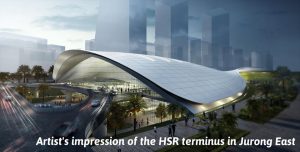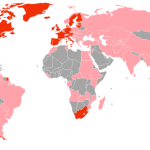Minister for Transport remains optimistic about he HSR project linking the two capitals will benefit both its peoples
The construction of the HSR Project linking Singapore and KL has been suspended since two years ago. The Minister for Transport, Mr Khaw Boon Wan, wrote in Facebook today that the Malaysian Senior Minister Azmin Ali has written to him to request an extension of 7 months to discuss Malaysia’s proposed changes to the HSR project linking Malaysia and Singapore.

Mr Khaw said as any project change requires Singapore’s agreement, the extended suspension of the HSR project linking the two capitals will allow both countries to assess the changes that Malaysia has in mind.
Table of Contents
In the spirit of bilateral cooperation, the Ministry of Transport has agreed to a final extension of the suspension period for the HSR project linking the two countries to 31 December 2020.
Mr Khaw said: “This should provide sufficient time for Malaysia to clarify its proposal and for both sides to assess the implications of the proposed changes. COVID-19 pandemic does inconvenience the discussions but tele-conferencing can largely overcome the difficulty. The key is joint commitment to the project’s vision and mutual trust. Nevertheless, the HSR is a complex project, and both sides have to be convinced that the changes do not undermine the original intent of the project.”
Mr Khaw added that he remains optimistic that the HSR project linking the two capitals will benefit both its peoples.
Property market stakeholders do not expect the deferment of the Kuala Lumpur-Singapore High Speed Rail (HSR) project to significantly affect Jurong property prices. Speaking to The New Paper (TNP) in September 2018, some of these analysts said that High Speed Rail (HSR) project only forms part of the blueprint for the rejuvenation of Jurong and the Jurong Lake Gardens area.
Jurong Lake Gardens is opening progressively from 2019, with new attractions and enhanced community spaces to serve residents, workers and visitors. As a people’s gardens, residents can look forward to nature-themed and water play areas, lifestyle and sports facilities, as well as a restored swamp forest and wetlands.
There is now some 160 hectares of land that is yet to be developed within the 360-hectare district. Draft Master Plan 2019 promises to design a greener way of life with the Jurong Lake Gardens.
New housing and community facilities in the West will be nestled within lush green spaces, close to parks and nature corridors. They will be developed sensitively, allowing biodiversity to thrive and co-exist in harmony with humans. By integrating developments with greenery, residents will be able to enjoy a good quality living environment.
According to Master Plan 2019 projects like Jurong Lake Gardens will enable the discovering of nature at every corner. With new parks and enhancements to existing green spaces and waterways, communities will be able to get closer to nature for leisure and recreation. These green and blue networks, in areas like the Jurong Lake Gardens, will also help to enhance biodiversity in our living and working environments.
The Jurong Lake District transformation will include marked change of a part of that area into major tourist destination said the Senior Minister of State (SMS) for Trade and Industry, Chee Hong Tat. The SMS made the announcement on the Jurong Lake District transformation at the Tourism Industry Conference organised by the Singapore Tourism Board (STB) on April 2019,
Mr Chee said that the Jurong Lake District transformation will be in line with Singapore Tourism Board’s strategy to spread out its tourism offerings across different parts of Singapore.
The SMS said, “we will be launching an Expression of Interest exercise for a new integrated tourism development with attractions, hotel and other complementary lifestyle offerings such as F&B and retail at the Jurong Lake District. With its unique waterfront environment and location adjacent to the new Jurong Lake Gardens and the new Science Centre, we envision this area to be transformed into a key attraction from 2026. The Expression of Interest exercise will close in early November this year, and we look forward to receiving your ideas and proposals.”
The Jurong Lake District transformation will see a 7-hectare site being redeveloped to include new integrated tourism attractions.
Currently the site is vacant and is situated next to the Chinese Garden MRT station. The new Science Centre is set to move to this location from Jurong Town Hall next year.
The Jurong Lake District transformation is part of the Government’s plans to change “preconceived notions” that Jurong is “far away, inaccessible, industrial estate”, said STB chief executive officer Keith Tan. Mr Tan added that there is no specific concept for the new tourism site as this would depend on the ideas submitted through the expression of interest exercise. The STB chief said there was keen interest in the site from industry players.
The Jurong Lake District transformation to include the integrated tourism attractions is expected to bring the shine back to the area – part of which was lost after the Kuala Lumpur-Singapore High Speed Rail (HSR) project was suspended.
Mr Tan who said that the STB’s plans for Jurong Lake District transformation is not dependent on the take-off of the HSR project, added that the eventual attractions to be developed there will be deeply integrated into the larger precinct.
“Next door will be the new national Science Centre, across the lake will be Jurong Lake Gardens.That makes it quite distinctive from some of the other standalone attractions in Singapore,” he said.
The Draft Master Plan 2019 also gives Jurong Lake District a big boost. The 360-hectare Jurong Lake District (JLD) will be the largest mixed-use business district outside the city centre, with quality offices, housing, amenities and abundant green spaces. A complementary leisure and recreational cluster has also been planned around Jurong Lake to leverage on the area’s unique lakeside and garden setting.






